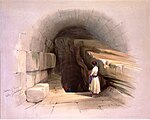Ma'ale HaZeitim

Ma'ale HaZeitim (Hebrew: מעלה הזיתים. lit. Olive Heights) is a Jewish Israeli settlement in East Jerusalem, located on the Mount of Olives, near the Palestinian neighborhood of Ras al-Amud. In 2010, its inhabitants numbered some 250 people belonging to 50 families. In 2011 it was projected to house 110 families and eventually merge with the new settlement of Ma'alot David, designed to replace an old police station across the street from Ma'ale HaZeitim, which would make them become the largest Jewish settlement in East Jerusalem. By 2016 Ma'ale HaZeitim was housing about 90 families and the adjacent project, now called Ma’alot David, had 23 housing units. In 2017, construction started on a community center, which will include two synagogues, a kindergarten, a higher learning institution, a library and an event hall, all overlooking the Temple Mount.The international community considers Israeli settlements in the West Bank illegal under international law, but the Israeli government disputes this.
Excerpt from the Wikipedia article Ma'ale HaZeitim (License: CC BY-SA 3.0, Authors, Images).Ma'ale HaZeitim
Jerusalem Ras al-Amud
Geographical coordinates (GPS) Address Nearby Places Show on map
Geographical coordinates (GPS)
| Latitude | Longitude |
|---|---|
| N 31.773333333333 ° | E 35.240277777778 ° |
Address
9114001 Jerusalem, Ras al-Amud
Jerusalem District, Israel
Open on Google Maps









